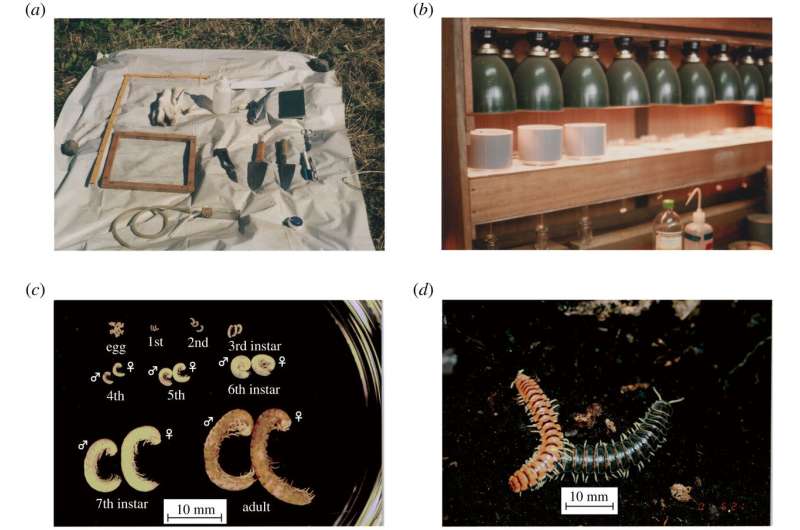January 13, 2021 report
Eight-year periodicity of train millipede confirmed

Bob Yirka
news contributor

A trio of researchers with the Forestry and Forest Products Research Institute and Shizuoka University, both in Japan, has confirmed the eight-year periodicity of the train millipede. In their paper published in the journal Royal Society Open Science, Keiko Niijima, Momoka Nii and Jin Yoshimura describe their multi-year study of the myriapod invertebrate Parafontaria laminata armigera Verhoeff, which is endemic to Japan, and what they learned about it.
Back in the early 20th century, Japanese engineers built train lines in remote mountain regions. In 1920, train operators working in a certain forested area were surprised to find teeming mounds of white millipedes covering the tracks so densely that trains could not pass. They persisted for a short amount of time before subsiding, allowing service to be restored. Then, less than a decade later, the millipedes returned once more, once again disrupting service. Thereafter, the millipedes (which became known as train millipedes) appeared periodically, leading some to believe that they had life-stage periodicity similar to that seen in cicadas (which are insects)—a behavior that had not been previously observed in an arthropod. In this new effort, the researchers set out to confirm the periodicity of the train millipede and its true cycle length.
The work involved venturing on a regular basis to the mountain location of the millipede swarms over many years. Each visit involved collecting specimens, which they studied in their lab. They were looking to see if there were new juveniles born each year, or only in the years after the swarms. As time passed, it became clear to the researchers that the juveniles were developing over eight years. They also found that there were multiple broods in the region that did not mature over the same cyclic periods. They named the brood that covered the train tracks Brood VI and found that records kept by train workers agreed with the juvenile growth cycle—the swarms occurred every eight years, confirming the periodicity of the millipedes.
Prior research has suggested that cicadas evolved periodicity as a reaction to global cooling—it is not known if the millipedes developed their periodicity for the same reason.
Written for you by our author —this article is the result of careful human work. We rely on readers like you to keep independent science journalism alive. If this reporting matters to you, please consider a (especially monthly). You'll get an ad-free account as a thank-you.
More information: Keiko Niijima et al. Eight-year periodical outbreaks of the train millipede, Royal Society Open Science (2021).
Journal information: Royal Society Open Science
© 2021 Science X Network




















